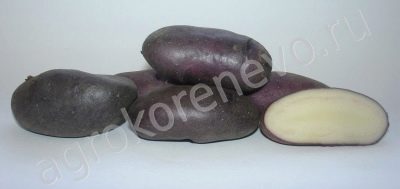
- Authors: Simakov Evgeniy Alekseevich, Grigoriev Gennady Vasilievich, Mityushkin Aleksey Vladimirovich, Uskov Aleksandr Irinarkhovich, Salyukov Sergey Sergeevich, Zhuravlev Aleksey Alekseevich, Ovechkin Sergey Valentinovich (VNIIKH named after A.G. Lorkh)
- Year of approval: 2014
- Appointment: dining room
- Tuber weight, g: 77-112
- Peel color: blue
- Color of the pulp: cream
- Starch content,%: 12,6-15,9%
- Tuber shape: elongated oval
- Peel structure: smooth
- Flowers: small, low to medium intensity of anthocyanin coloration of the inner side
When choosing potatoes for planting, it is recommended to pay attention to varieties that are hardy, tasty and resistant to diseases. These are the characteristics of the mid-early potato variety with the beautiful name Vasilek, which is a Russian selection.
Breeding history
The potatoes were obtained on the basis of the All-Russian Research Institute of Potato Farming named after V.I. A.G. Lorkha in 2007. The authorship belongs to a group of domestic scientists, among them E. A. Simakov, S. V. Ovechkin and S. S. Salyukov. When breeding, the following parental forms were used: Chugunka and hybrid D-31-88. In the State Register of Breeding Achievements of the Russian Federation, potatoes appeared after many years of variety trials in 2014. The vegetable is zoned in the Central region of the country.
Description of the variety
Potato Cornflower is a medium-height bush of an intermediate type. The bush is characterized by semi-erect stems, medium-sized dark green foliage and a powerful root system. During the flowering period, medium-sized red-purple flowers appear on the bushes.
Characteristics of the appearance of the bush and root crops
On average, up to 12-15 root crops are formed on 1 bush. The vegetable has a regular, elongated-oval shape, a perfectly smooth surface with small eyes on the peel. Potatoes weighing 77-112 grams grow. The peel of the vegetable is thin. A characteristic feature of the variety is the unusual color of the skin - blue or blue-violet.
It should be noted that the variety has high keeping rates (over 96%) - up to 3-4 months. In high humidity conditions, potatoes tend to germinate quickly. The optimum temperature for storing potatoes is considered to be up to +3 degrees, not higher. Vegetables tolerate transportation perfectly, without loss of marketable qualities of potatoes.
Purpose and taste of tubers
Potatoes are famous for their high taste. The light creamy pulp of the vegetable has a dense, mealy, oily and starchy structure, where there is absolutely no wateriness. Sometimes there are yellowish streaks in the creamy pulp. During peeling and heat treatment, the potatoes do not darken. Potato pulp tends to be moderately boiled, which ensures its widespread use in cooking.
The pulp of this potato species contains up to 16% starch, as well as a high content of vitamins of groups C and E. The advantage of the species is high levels of antioxidants, carotenoids, which is important for dietary nutrition.
The purpose of the table variety is that potatoes are ideal for boiling, frying, and also added to soups, borscht, salads. In addition, the variety is suitable for baking, stuffing, boiling in a peel.
Maturation
Potato Cornflower belongs to the group of mid-early species.From full germination to the harvesting period, only 80-100 days pass. Mass germination occurs 2 weeks after planting. You can harvest in August.
Yield
The yield indicators for the potato variety are excellent. On average, from 1 hectare of plantations, you can get from 93 to 256 centners of potatoes. With proper and consistent care, 70 kg can be dug out from 1 weave of the garden. The maximum yield is noted at the level of almost 500 centners per hectare.
Growing and caring
Planting potatoes is carried out after full stabilization of weather conditions. Because with the slightest return frost, potatoes may die. The best time for planting is the end of March - early April. The planting material must be healthy, dense, without traces of infection. A month before planting, the tubers are prepared for germination, periodically sprinkling with water. The optimal layout for planting is 70x20 cm or 60x30. The best predecessors will be zucchini, cucumbers, cabbage and beets.
During growth, potatoes need standard agricultural techniques: hilling and loosening the soil, preventing diseases, regular watering and feeding. It is also important not to forget about the timely replacement of seed material. When feeding, you should not abuse nitrogen-containing complexes, since excess can lead to increased growth of tops, and not fruits.

Planting potatoes is one of the main spring activities traditional for Russian gardeners. There are many ways to plant this vegetable, allowing you to get a good harvest in different conditions and climates. Before planting, you need to carefully prepare the planting material, correctly determine the timing, competently prepare the soil.


Soil requirements
Potatoes grow comfortably in nutritious, not very heavy soils that are breathable, moist, and also have a low acidity. Too heavy soil is recommended to be well fertilized with organic complexes before planting.

Required climatic conditions
It is recommended to grow potatoes in areas well-lit by the sun, which are protected from cold winds and drafts.
Disease and pest resistance
This variety is very much appreciated by gardeners and farmers for its high immunity. Potatoes are resistant to late blight of tubers and tops, cancer, wrinkled rot and banded mosaic. The variety is vulnerable to golden nematode, common scab and ring rot. To avoid insect attacks, timely preventive spraying and soaking in insecticides are needed.

Potatoes are a popular vegetable crop that many gardeners planted on their site. But growing a bountiful harvest of tasty and large tubers is unlikely to succeed if the beds are not properly protected from the most common diseases and pests.Often, the development of diseases of various etiologies of potatoes goes unnoticed, so it is important to identify the problem in time and eliminate it.
















































































